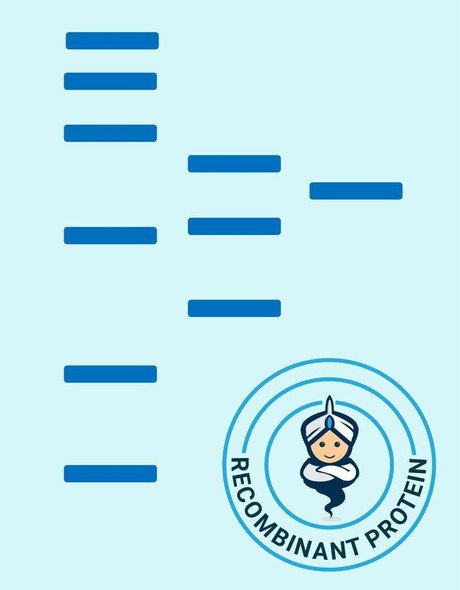Cytokines Recombinant Proteins
Human TNFR Recombinant Protein (RPPB1008)
- SKU:
- RPPB1008
- Product Type:
- Recombinant Protein
- Species:
- Human
- Uniprot:
- Q07011
- Research Area:
- Cytokines
Description
| Product Name: | Human TNFR Recombinant Protein |
| Product Code: | RPPB1008 |
| Size: | 10µg |
| Species: | Human |
| Target: | TNFR |
| Synonyms: | Tumor Necrosis Factor Receptor Superfamily Member 9,Tumor Necrosis Factor Receptor Superfamily, Member 9, T-Cell Antigen 4-1BBHomolog, 4-1BB Ligand Receptor, T-Cell Antigen ILA, CD137 Antigen, CDw137,CD137, ILA, Interleukin-Activated Receptor, Homolog Of Mouse Ly63,Induced ByLymphocyte Activation (ILA), Homolog Of Mouse 4-1BB, Receptor Protein 4-1BB, TCell Antigen ILA, 4-1BB. |
| Source: | Sf9 Insect cells |
| Physical Appearance: | Sterile Filtered colorless solution. |
| Formulation: | TNFR protein solution (0.5mg/ml) contains PhosphateBuffered Saline (pH 7.4) and 10% glycerol. |
| Stability: | Store at 4°C if entire vial will be used within 2-4 weeks. Store, frozen at -20°C for longer periods of time.�For long term storage it is recommended to add a carrier protein (0.1% HSA or BSA).�Avoid multiple freeze-thaw cycles. |
| Purity: | Greaterthan 90.0% as determined by SDS-PAGE. |
| Amino Acid Sequence: | ADLFERTRSLQDPCSNCPAG TFCDNNRNQI CSPCPPNSFS SAGGQRTCDI CRQCKGVFRT RKECSSTSNA ECDCTPGFHCLGAGCSMCEQ DCKQGQELTK KGCKDCCFGT FNDQKRGICR PWTNCSLDGK SVLVNGTKER DVVCGPSPADLSPGASSVTP PAPAREPGHS PQLEPKSCDK THTCPPCPAP ELLGGPSVFL FPPKPKDTLM ISRTPEVTCVVVDVSHEDPE VKFNWYVDGV EVHNAKTKPR EEQYNSTYRV VSVLTVLHQD WLNGKEYKCK VSNKALPAPIEKTISKAKGQ PREPQVYTLP PSRDELTKNQ VSLTCLVKGF YPSDIAVEWE SNGQPENNYK TTPPVLDSDG SFFLYSKLTVDKSRWQQGNV FSCSVMHEAL HNHYTQKSLS LSPGKHHHHH H |
TNFR1 belongs to the TNF-receptor superfamily. TNFR1 is a receptor for TNFSF2/TNF-alpha and homotrimeric TNFSF1/lymphotoxin-alpha.There are 2 types of soluble TNF receptors: sTNFR-I and sTNFR-II, which act to neutralize the biological activities of TNF alpha and TNF beta. The levels of these soluble receptors seem to increase as a result of shedding of the extracellular domains of the membrane bound receptors. TNF-a, TNFR1 and TNFR2 have roles in cellular differentiation. TNFR1 and TNFR2 function in cell type-specific renal injury.TNFR1 is capable of signaling both cell survival and apoptosis. TNFR1-induced apoptosis requires 2 sequential signaling complexes. TNFR1 is capable of activating NF-kappaB, mediate apoptosis, and function as a regulator of inflammation. Oxidative stress promotes TNFR1 and TNFR2 self-interaction, ligand-independent and enhanced ligand-dependent TNF signaling. TNFR1 contributes to the induction of non-cytocidal TNF effects including anti-viral state and activation of the acid sphingomyelinase. Human TNFR1 has a major region which controls cell surface expression. High levels of soluble TNF receptors are found in the amniotic fluid of pregnant women.Germline mutations of the extracellular domains of TNFR1 are linked to the autosomal dominant periodic fever syndrome. The impaired receptor clearance is believed to be a mechanism of the disease. Familial hibernian fever (FHF) is caused by defects in TNFRSF1A gene.
TNFR produced in Sf9 Baculovirus cells is a single,glycosylated polypeptide chain containing 411 amino acids (18-186 a.a.) andhaving a molecular mass of 45.3kDa. (Migrates at 40-57kDa on SDS-PAGE underreducing conditions).TNFR is expressed with a 239 amino acid hIgG-His-tag atC-Terminus and purified by proprietary chromatographic techniques.
| UniProt Protein Function: | TNFRSF9: Receptor for TNFSF9/4-1BBL. Possibly active during T cell activation. |
| UniProt Protein Details: | Protein type:Membrane protein, integral; Receptor, misc. Chromosomal Location of Human Ortholog: 1p36 Cellular Component: extracellular space; integral to plasma membrane; external side of plasma membrane Molecular Function:cytokine binding; receptor activity Biological Process: negative regulation of cell proliferation; apoptosis |
| NCBI Summary: | The protein encoded by this gene is a member of the TNF-receptor superfamily. This receptor contributes to the clonal expansion, survival, and development of T cells. It can also induce proliferation in peripheral monocytes, enhance T cell apoptosis induced by TCR/CD3 triggered activation, and regulate CD28 co-stimulation to promote Th1 cell responses. The expression of this receptor is induced by lymphocyte activation. TRAF adaptor proteins have been shown to bind to this receptor and transduce the signals leading to activation of NF-kappaB. [provided by RefSeq, Jul 2008] |
| UniProt Code: | Q07011 |
| NCBI GenInfo Identifier: | 728738 |
| NCBI Gene ID: | 3604 |
| NCBI Accession: | Q07011.1 |
| UniProt Related Accession: | Q07011,AAB34924 |
| Molecular Weight: | 27,899 Da |
| NCBI Full Name: | Tumor necrosis factor receptor superfamily member 9 |
| NCBI Synonym Full Names: | tumor necrosis factor receptor superfamily, member 9 |
| NCBI Official Symbol: | TNFRSF9�� |
| NCBI Official Synonym Symbols: | ILA; 4-1BB; CD137; CDw137�� |
| NCBI Protein Information: | tumor necrosis factor receptor superfamily member 9; CD137 antigen; T cell antigen ILA; T-cell antigen ILA; 4-1BB ligand receptor; homolog of mouse 4-1BB; receptor protein 4-1BB; T-cell antigen 4-1BB homolog; induced by lymphocyte activation (ILA); interleukin-activated receptor, homolog of mouse Ly63 |
| UniProt Protein Name: | Tumor necrosis factor receptor superfamily member 9 |
| UniProt Synonym Protein Names: | 4-1BB ligand receptor; CDw137; T-cell antigen 4-1BB homolog; T-cell antigen ILA; CD_antigen: CD137 |
| UniProt Gene Name: | TNFRSF9�� |
| UniProt Entry Name: | TNR9_HUMAN |






